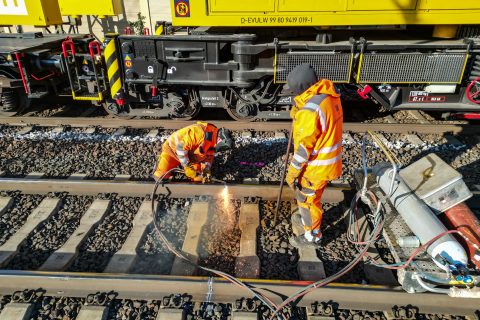A year ago today: Ukrainian Railways enter emergency mode

At the dawn of 24 February 2022, the first war sirens went off in Kyiv, accompanied by the first bombing of the city. A couple of hours later, Ukrainian Railways announced they had entered an emergency operational mode. From there, the rest is history, consisting of a domino of effects in business, transport, energy, and, first and foremost, human security and life.
The months following the Russian invasion of Ukraine were characterised by insecurity concerning human lives, the European and global economies, and the supply chains. Russia was and still is a leading global economy, so understandably, a move like invading Ukraine would have immediate adverse effects on regional and global scales.
Another thing that characterised 2022 from late February onwards was panic. Panic and drastic solutions are direct products of security concerns, and the rail transport sector had plenty of both in the past year.
If there is one lesson that the logistics and rail freight sectors learnt, it should be that flexibility is key. The world and supply chains might have adjusted to a ‘new reality’ by now; however, stability is far from always granted in the transport world. Nevertheless, 2022 belongs to the past now. This article aims to document the most important developments in a year monopolised by a war that could be seen approaching but was never avoided.
Do you want to join the discussion about rail freight opportunities between Poland and Ukraine? Join us at the RailFreight Summit Poland 2023.
First hours-emergency mode
The tension between Ukraine and Russia was building up for weeks before the invasion. Many could see the looming dangers, but it’s unclear whether anyone expected an escalation resulting in a full-scale armed conflict. Despite a general feeling of disbelief, several analysts talked about the possible effects that escalated tension or war could deliver on Eurasian rail transport and supply chains.
In any case, the unavoidable occurred in the first hours of 24 February 2022. Russia invaded Ukraine, and the first news from the eastern European country mainly focused on the bombings and military movements in Kyiv and east Ukrainian provinces. Regarding transport, the first news that surfaced was from Ukrainian Railways announcing an emergency operational mode coordinated by the relevant headquarters.
“We are a company that provides critical transport infrastructure. We have to transport passengers safely and on time and ensure the transportation of goods at all times. As of today, we will work from our Operational Headquarters, which will be coordinated with the Government, the National Security and Defense Council and other bodies,” announced the company on its official website.
First days: evacuations, sanctions, humanitarian aid and divestments
The response of Ukrainian Railways to the unfolding invasion was drastic. The state-owned company set up evacuation passenger trains in no time, moving civilians away from the war front in what has been one of the most challenging and heroic operations in the history of railways in Europe.
At the same time, the European response to Russia was also proximate. The first sanction package on the country was released just hours after hostilities commenced. Companies were on time to follow the sanctions and start divesting from the Russian economy, even though a large majority of them did so before the sanctions as a result of ethical reasons. Transport companies were no exception. Giants like Maersk, MSC and CMA CGM and smaller logistics and rail freight companies were among the first to do so.
All that took place while European rail logistics ran against the clock to set up the first humanitarian trains destined for Ukraine. DB, RCG, PKP, Rénfe, SNCF, Mercitalia, FS Group, and more were the frontrunners of humanitarian rail services, which until early April 2022, accounted for the transport of 10,000 tonnes of aid cargo.
Few weeks into the war: what happens to the Silk Road?
Companies started excluding Russia from their business; however, what happened after that could be described as a ‘Silk Road paranoia’. Realising Russia might not be an eligible Silk Road partner and transit route hit the industry hard. Companies struggled to see whether sanctions applied to their transport products, whether they could complete payments with Russian banks, and who was allowed to do what and when.
Generally speaking, this period was the most challenging for Eurasian rail since uncertainty was dominant. That is when the Middle Corridor made a deus-ex-machina appearance to save the day. The focus on this route was unprecedented as it was considered the best alternative to the blocked and problematic Russian route. Nevertheless, expectations were soon minimised as the corridor could not absorb the volumes of the Russian route.
With more sanctions in place now and then, it gradually became more transparent and easy for companies to define what their dos and don’ts were for transport. Transit via Russia was still possible, for instance, given that the shipper, cargo and bank involved were not sanctioned. Despite that, more companies continued phasing out their interaction with Russia or Russian Railways. Some examples are Finland and the Baltic States.
Few months into the war: Ukrainian exports and energy
After the dust of the first months of war settled, another major challenge emerged. It was the Ukrainian agricultural produce, which due to the war, was in danger of remaining in the silos until rotten. This wasn’t just a matter of financial losses for Ukraine. It was a matter of securing food for the world since Ukraine is widely known as Europe’s ‘breadbasket’ exporting grain around the globe.
With Ukrainian Black Sea ports blocked, rail undertook the humongous task of moving, at least a part, of Ukrainian agricultural produce to western Europe and further via ports. The mission was unprecedented for everyone involved since communication was almost impossible. In any case, several European companies joint the enterprise, which despite some failures and hick-ups proved to be relatively successful since it paved the way for more rail services and infrastructure between western Europe and Ukraine.
Simultaneously, dark and stormy clouds of an impending energy crisis started gathering over Europe because of the approaching winter. European economies relied heavily on Russian oil and other natural resources for heating, mobility and electricity production. As a result, their scarcity led them to start looking for alternatives while energy prices spiked. This impacted the rail freight industry in two ways: first, by increasing operational costs, and second, by providing more space on rail for energy sources like coal.
A year into the war: a sense of stabilisation
As 2022 had just a couple of months left, the situation started stabilising. The impact, both societal and economic, was irreversible. The same applied to the Eurasian rail supply chain. Silk Road volumes dropped significantly between China-Europe, while they grew between Russia-China. Many feared this could end the Silk Road, while others said it was a matter of reconfiguration and a new approach to the concept.
Despite the severe effects, the Silk Road made it through 2022 and kept going. The new trend now is flexibility and tapping new markets that might have been overlooked before due to the dependency on Russia and China as commerce partners. The war in Ukraine is not the only one affecting the development of the Eurasian rail supply chain. Research findings have shown that the Silk Road is subject to various shifts, including inflation, a slow global economy, the energy crisis or even a pandemic.
Ultimately, the market and supply chains will find their way – at least, that is what economists have been claiming for years. What matters most is peace and the security of people. In the end, these have been compromised more than anything for a whole year.
RailFreight Summit Poland
At the RailFreight Summit Poland 2023, the opportunities for more rail freight between Ukraine and Poland is a topic on the agenda. During a dedicated session, facts and figures will be presented, followed by a discussion and networking session to encourage new business relations.
The RailFreight Summit Poland takes place on 19 & 20 April, in the capital city of Warsaw. Registrations are already open. You can find more information on the event site.
Follow RailFreight.com on Google News and get the latest industry updates.
You just read one of our premium articles free of charge
Want full access? Take advantage of our exclusive offer





